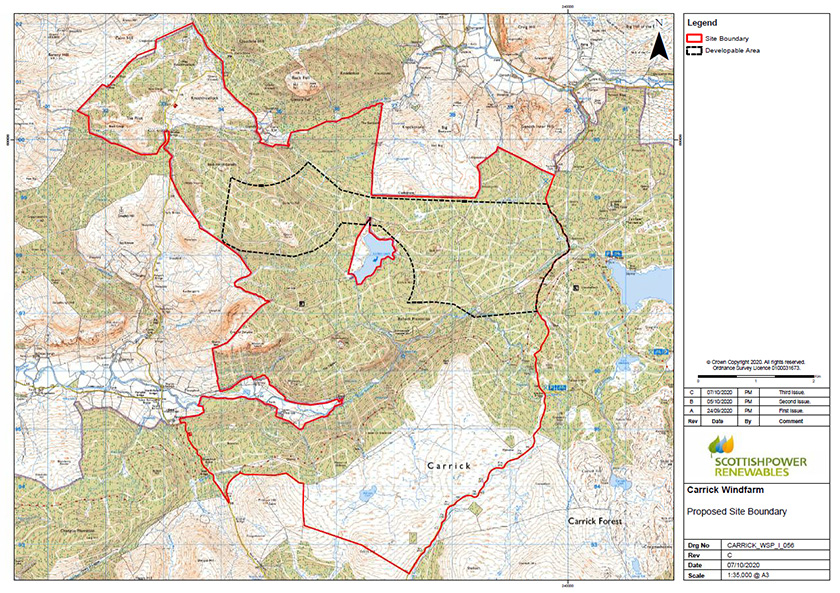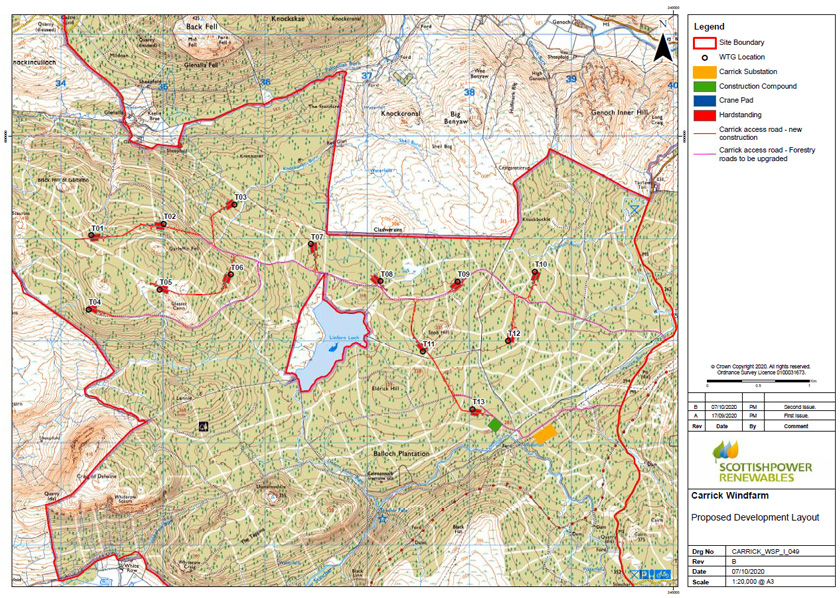The proposed Site boundary is shown below:

View a larger version of the map above
The Proposed Development layout is shown below:

View a larger version of the map above
Key project details
 | 13 wind turbines with a maximum height to blade tip of 200 metres. |
 | Generating capacity of around 72 megawatts. |
 | Energy Storage Facility (i.e. battery) with a storage capacity of around 20 megawatts. |
 | Generating enough electricity to supply electricity for the equivalent of over 46,000* homes. |
*Based on the following calculation: 72.8 MW (installed capacity) x 0.266 “onshore wind” load factor (from Digest of UK Energy Statistics July 2020) x 8,760 hours (hours per year)/3,618 kWh (average domestic annual consumption) = 46,921 homes powered equivalent.
The Site at Carrick has been chosen for a number of reasons; it benefits from high wind speeds, it is within a low population density area, with a separation of over 4.6 km from the Site boundary to the nearest settlement at Straiton, and also benefits from an existing commercial forestry track network and close proximity to transport and grid connections. The wind turbines are sited in an area that is free from statutory designations.
We presented our initial design layout in the Carrick Windfarm Scoping Report in May 2020. Since then, and in response to feedback that we have received and survey data obtained, the following changes have been made to the layout:
- The number of wind turbines has been reduced from 17 to 13, reducing landscape and visual effects from a number of sensitive locations.
- The position of wind turbines and infrastructure has been refined to minimise impacts on peat, ecological and ornithological receptors. In particular, for ecological receptors, we have avoided watercourses and minimised crossings to reduce potential impacts on habitat features used by otter and water vole.
- The infrastructure design has used existing forestry tracks where possible to minimise the amount of new track required to be constructed which will reduce the impact to the forest and existing habitats.
- The layout has been improved to further increase separation between wind turbines and residential properties, therefore reducing potential impact on residential amenity and noise.
- A wind turbine has been removed and other locations refined in the south of the Site to improve the view from Shalloch on Minnoch and reduce the proximity of wind turbines to the Merrick Wild Land.
- A wind turbine has been moved further away from a known cultural heritage asset (Scheduled Ancient Monument) near Glenella Fell / Knockinculloch.
Development and Environmental Impact Assessment (EIA) process
Feasibility Study: 2019 | A feasibility study was undertaken prior to scoping to understand the constraints of the Site and determine whether it was a viable option for development. |
Scoping: May 2020 | The process whereby we consulted with various stakeholders and identified what aspects and potential effects of the Proposed Development should be covered within the Environmental Impact Assessment Report (EIAR). An Environmental Impact Assessment Scoping Report was submitted to the Scottish Government in May 2020 and the results have helped to inform the windfarm layout design. |
Initial Pre- Application Consultation: June 2020 | Information on the Proposed Development was issued to residents and the local community in the form of a consultation leaflet. Responses from members of the public were taken into consideration in the development of the design. |
Onsite and desktop environmental surveys: September 2018 – October 2020 | Research to establish what the conditions of the Site are like at present (known as the baseline) has been ongoing since 2018. The results of this will allow the effects of the predicted changes resulting from the Proposed Development to be assessed within the EIA. |
Environmental Impact Assessment: Ongoing | An Environmental Impact Assessment is an iterative process to optimise the design to achieve balance between site performance and environmental effects. It is a formal part of the windfarm planning process, which involves undertaking environmental surveys of the Site by independent specialists to quantify and identify any significant environmental effects the windfarm may have. The Environmental Impact Assessment for Carrick Windfarm will assess the potential for effects from the following environmental topics: - Landscape and visual
- Noise
- Ecology
- Ornithology
- Archaeology and cultural heritage
- Access, traffic and transport
- Ecology and biodiversity
- Hydrology, hydrogeology, geology and soils
- Other issues including Forestry and Land Use, Aviation and Radar, Telecommunications, Climate and Carbon Balance
- Cumulative effects
The Environmental Impact Assessment will also seek to identify measures to eliminate, avoid, reduce or mitigate any potential significant effects, where possible. |
Second Pre-Application Consultation: October 2020 | The current online Public Information Event. |
Submission of Application for Consent: December 2020 | The application to build and operate the Proposed Development will be submitted to the Scottish Ministers, known as a Section 36 application. |
| Evaluation and determination of the Application | The Section 36 application will be administered by the Scottish Government Energy Consents Unit (ECU) on behalf of Scottish Ministers. There will be an opportunity at this stage for you to make formal representations on the application to the ECU. These will then be taken into account by Scottish Ministers when determining whether or not to grant consent for the Proposed Development. Timescales for determination are variable and dependent upon case specific issues but can take between 12 to 15 months. |
Go back to the main pageGo to the next page